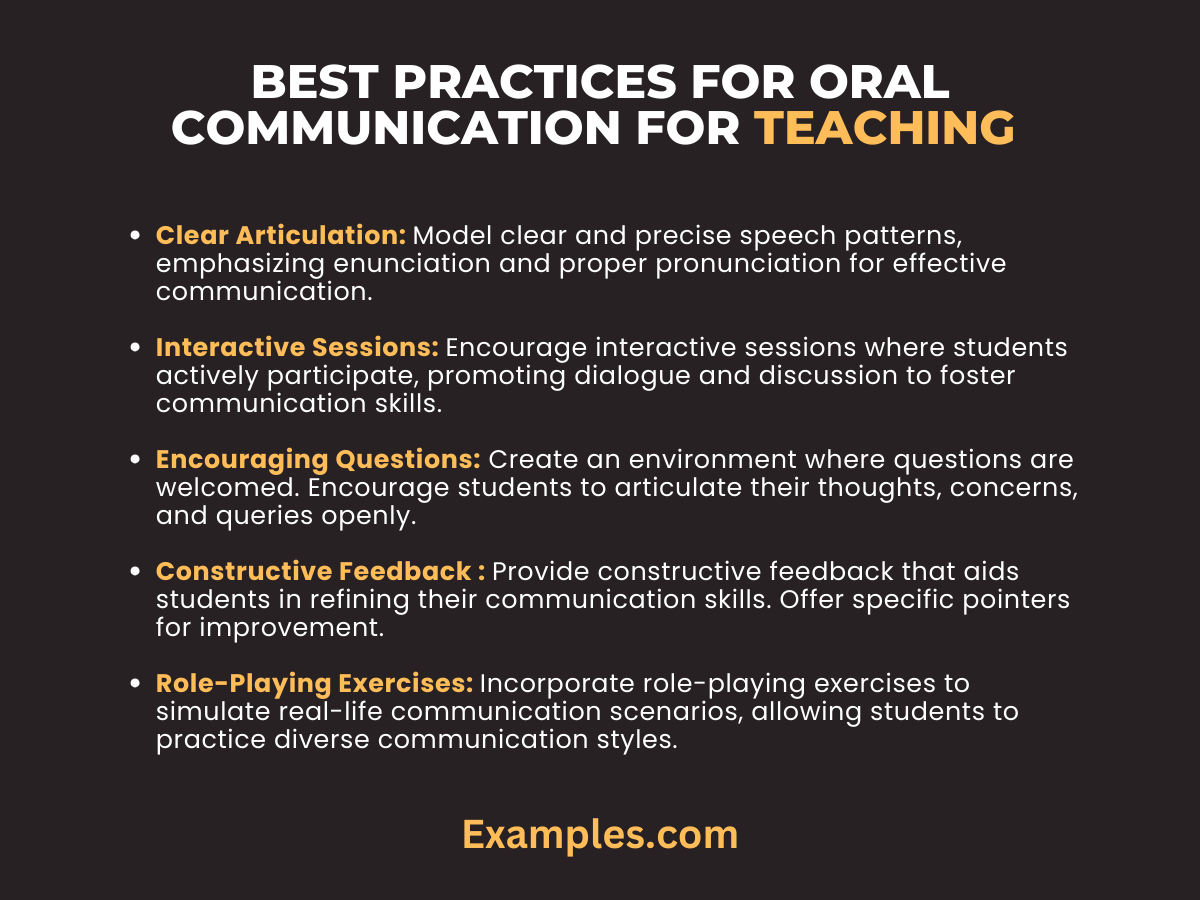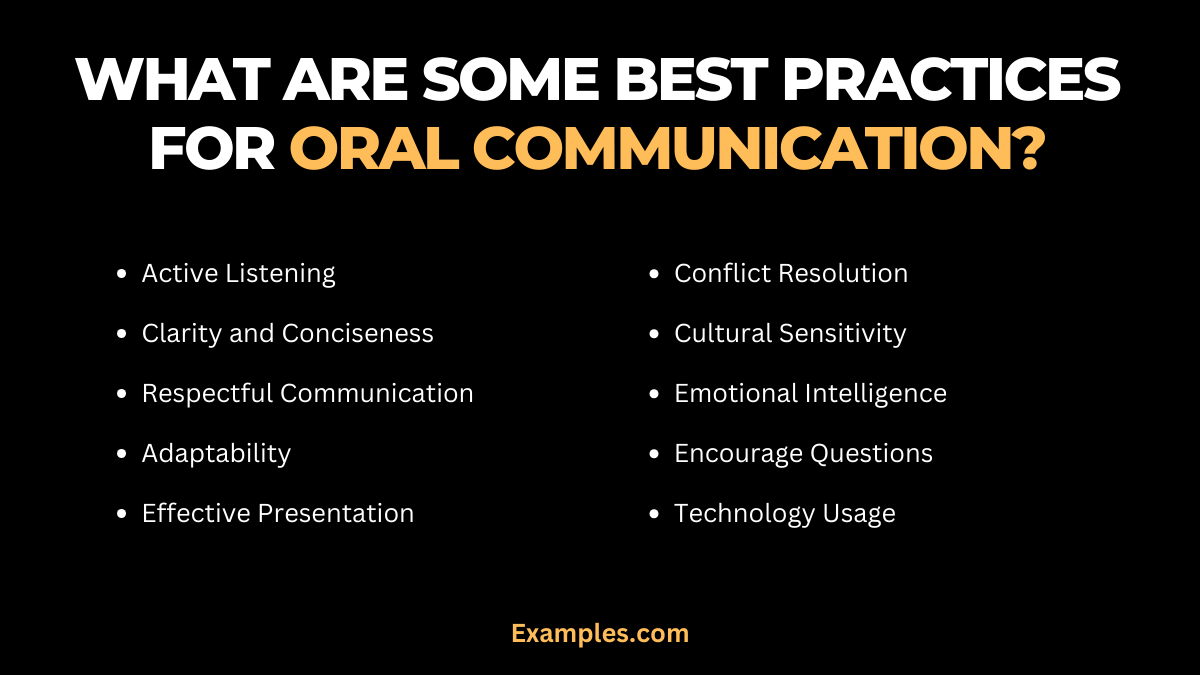29+ Best Practices for Oral Communication Examples
Unlock the secrets of effective communication with our guide on “Best Practices for Oral Communication.” Delve into the definition, explore historical perspectives, and learn essential tips. From honing your communication skills to understanding the origins, this comprehensive resource empowers you with actionable insights. Elevate your oral communication prowess and navigate various scenarios with confidence. Master the art of expressing yourself eloquently through proven tips and real-world examples.
30 Best Practices for Oral Communication Examples
Unlock the power of effective communication with our diverse set of daily life sentences. In various scenarios, these examples showcase the versatility of clear, impactful expression. From casual interactions to professional settings, master the art of conveying thoughts and emotions. Elevate your communication skills, foster connections, and navigate social exchanges seamlessly. Explore these 30 unique examples for a practical and engaging approach to improving your verbal and written communication.

- Morning Greetings: Start your day positively by warmly greeting friends, family, or colleagues.
- Expressing Gratitude: Cultivate a habit of thanking others for their contributions and kindness.
- Asking for Help: Politely seek assistance when faced with challenges, fostering collaboration.
- Sharing Opinions: Participate in discussions, expressing your thoughts while respecting diverse viewpoints.
- Active Listening: Demonstrate attentiveness when others speak, fostering understanding and empathy.
- Giving Compliments: Boost positive interactions by offering sincere compliments to friends and colleagues.
- Resolving Conflicts: Navigate disagreements diplomatically, promoting harmony and understanding.
- Apologizing: Acknowledge mistakes with a sincere apology, fostering accountability and growth.
- Project Updates: Keep team members informed by providing regular updates on ongoing projects.
- Encouraging Classmates: Offer support and encouragement to classmates facing challenges in academic settings.
- Group Discussions: Engage actively in group projects, ensuring everyone’s input is valued.
- Sharing Stories: Promote effective storytelling skills by sharing interesting anecdotes during conversations.
- Expressing Feelings: Confidently share emotions when discussing personal experiences or favorite subjects.
- Debating Topics: Enhance critical thinking by participating in friendly debates on various subjects.
- Collaborating on Assignments: Showcase teamwork by working collaboratively on academic assignments.
- Offering Assistance: Volunteer to help classmates or colleagues with their tasks, fostering mutual support.
- Peer Feedback: Provide constructive feedback to peers during presentations, encouraging improvement.
- Role-Playing Scenarios: Develop adaptability and problem-solving skills through communication role-playing.
- Celebrating Achievements: Reinforce positive communication habits by celebrating personal and collective accomplishments.
- Negotiating Solutions: Hone negotiation skills by seeking compromises during group activities.
- Participating in Class Debates: Sharpen critical thinking through active involvement in classroom debates.
- Expressing Concerns: Foster open dialogue by confidently communicating concerns with teachers or colleagues.
- Building Rapport: Create a friendly and inclusive environment by initiating conversations to build rapport.
- Peer Collaboration: Develop teamwork and communication proficiency by collaborating with peers on projects.
- Classroom Polls: Engage in democratic decision-making by participating in classroom polls and expressing opinions.
- Responding to Literature: Cultivate analytical and expressive communication by articulating responses to literature.
- Expressing Empathy: Demonstrate empathy by understanding and supporting classmates’ experiences.
- Time Management Discussions: Emphasize the importance of clear communication in planning by engaging in time management discussions.
- Showcasing Hobbies: Foster shared experiences by presenting personal hobbies and interests to classmates.
- Understanding Directions: Demonstrate the ability to understand and follow directions in various academic and social contexts.
Best Practices for Oral Communication for Listening
Enhancing oral communication begins with attentive listening. Follow these best practices to refine your listening abilities, a pivotal element in effective communication:
Active Engagement: Engage fully in conversations by maintaining eye contact, nodding, and providing verbal cues to signal understanding and interest. Active participation demonstrates attentiveness.
Avoiding Interruptions: Resist the urge to interrupt while others speak. Letting the speaker complete their thoughts fosters an environment of respect and understanding.
Clarifying and Summarizing: Summarize or paraphrase what you’ve heard to ensure comprehension. Seeking clarification when unclear demonstrates your commitment to understanding.
Open-Mindedness: Approach discussions with an open mind, welcoming diverse perspectives. Being receptive to different viewpoints enriches communication.
Patience and Empathy: Practice patience and empathy. Understand that not everyone communicates at the same pace or in the same manner, and respect these differences.
Limiting Distractions: Minimize distractions during conversations. Focus on the speaker, and if necessary, relocate to a quieter setting.
Best Practices for Oral Communication for Teaching
Enhance your teaching prowess by integrating effective oral communication practices into your pedagogy:

Clear Articulation: Model clear and precise speech patterns, emphasizing enunciation and proper pronunciation for effective communication.
Interactive Sessions: Encourage interactive sessions where students actively participate, promoting dialogue and discussion to foster communication skills.
Encouraging Questions: Create an environment where questions are welcomed. Encourage students to articulate their thoughts, concerns, and queries openly.
Constructive Feedback : Provide constructive feedback that aids students in refining their communication skills. Offer specific pointers for improvement.
Role-Playing Exercises: Incorporate role-playing exercises to simulate real-life communication scenarios, allowing students to practice diverse communication styles.
Varied Instructional Tools: Utilize diverse tools—visual aids, presentations, and interactive technology—to cater to different learning styles and enhance engagement.
Emphasizing Active Listening: Demonstrate and encourage active listening among students, emphasizing its importance in effective communication.
Structured Debates: Organize structured debates or discussions that require students to articulate and defend their viewpoints, promoting critical thinking and expression.
Peer Collaboration: Encourage teamwork and collaborative projects, where communication is key to successful group dynamics.
Cultivating Confidence: Build students’ confidence in communicating their ideas by creating a supportive and non-judgmental classroom atmosphere.
Best Practices for Oral Communication in the Workplace
Clear and effective communication in the workplace is pivotal for productivity, collaboration, and a positive work environment. Here are comprehensive best practices to enhance oral communication skills:
Active Listening and Feedback: Encourage active listening among employees to understand perspectives better. Foster an environment where feedback is welcomed, promoting continuous improvement and mutual understanding.
Clarity and Conciseness: Emphasize the importance of clear and concise communication. Encourage employees to express thoughts and ideas in a straightforward manner, avoiding ambiguity.
Respectful Communication: Create a culture of respect in communication. Encourage polite and respectful language, ensuring everyone feels valued and heard.
Adaptability in Communication: Highlight the significance of adapting communication styles to different audiences. Employees should be adept at tailoring their approach based on the recipient, be it colleagues, clients, or superiors.
Effective Presentation Skills: Offer training sessions on effective presentation techniques. This includes structuring content, utilizing visuals, and engaging the audience, empowering employees to deliver impactful presentations.
Conflict Resolution: Equip employees with conflict resolution strategies. Encourage open dialogue and teach negotiation skills to resolve conflicts amicably, avoiding disruptions in workflow.
Cultural Sensitivity: Sensitize employees to cultural diversity in communication. Foster understanding and tolerance toward diverse communication styles and cultural nuances.
Emotional Intelligence: Promote emotional intelligence in communication. Encourage self-awareness and empathy, allowing employees to navigate complex interactions with emotional intelligence.
Encourage Questions and Discussions: Foster an environment where asking questions and engaging in discussions is encouraged. This promotes a culture of curiosity and active participation.
Use of Technology: Train employees in using communication tools effectively. Whether it’s video conferencing, email etiquette, or instant messaging, familiarity with these tools streamlines communication.
Leadership Communication: Offer leadership training emphasizing effective communication. Leaders should serve as role models, displaying exemplary communication practices and promoting a communicative work culture.
What are some best practices for oral communication?

- Active Listening: Engage in attentive listening, fostering understanding and empathy in conversations.
- Clarity and Conciseness: Express thoughts clearly, avoiding ambiguity for effective communication.
- Respectful Communication: Use polite language to create a respectful and inclusive communication environment.
- Adaptability: Tailor communication styles to diverse audiences, ensuring effective interaction with different groups.
- Effective Presentation: Develop impactful presentation skills, including content structuring and audience engagement techniques.
- Conflict Resolution: Equip yourself with negotiation skills to amicably resolve conflicts in the workplace.
- Cultural Sensitivity: Be aware of and respect cultural differences in communication styles.
- Emotional Intelligence: Cultivate emotional intelligence for navigating complex interactions with self-awareness and empathy.
- Encourage Questions: Foster a culture of curiosity and active participation by encouraging questions and discussions.
- Technology Usage: Use communication tools effectively, such as video conferencing and email etiquette.
How to improve your eye contact skill for oral communication?
- Practice Regularly: Build eye contact skills through regular practice in various social situations.
- Maintain Balance: Strike a balance; avoid excessive or insufficient eye contact to appear confident and engaged.
- Focus on Forehead: If direct eye contact feels uncomfortable, focus on the forehead to create a similar impression.
- Use Conversational Gestures: Combine eye contact with appropriate gestures to enhance communication effectiveness.
- Establish Connection: Connect with your audience by maintaining eye contact, conveying sincerity, and building trust.
- Avoid Staring: Steer clear of prolonged staring, as it may come across as intimidating or uncomfortable.
- Practice in Front of a Mirror: Evaluate and refine your eye contact skills by practicing in front of a mirror.
- Seek Feedback: Solicit feedback from friends or colleagues to gain insights and improve your eye contact.
- Visualize Success: Visualize successful communication scenarios with confident and effective eye contact.
- Attend Workshops: Explore workshops or courses specifically designed to enhance eye contact skills in communication.
In conclusion, the “Best Practices for Oral Communication” guide offers a comprehensive understanding of effective communication strategies in various scenarios, from everyday interactions to specialized settings like education and the workplace??. To further enhance your communication skills and apply these practices in real-world situations, additional resources can be instrumental.
Harvard’s Professional Development blog provides “8 Ways You Can Improve Your Communication Skills,” offering actionable tips to refine and develop your communication abilities. This resource is particularly valuable for those looking to enhance their professional communication skills. You can explore these tips in detail at Harvard DCE??.
Moreover, HelpGuide.org presents a detailed overview of effective communication, emphasizing the importance of understanding emotions and intentions behind information exchange. This guide is beneficial for improving communication in both personal and work relationships. For a deeper dive into these aspects, visit HelpGuide.org??.
These external resources complement the knowledge provided in the “Best Practices for Oral Communication” guide, offering a broader perspective and practical tips to apply in various aspects of life. They are tailored to aid in avoiding misunderstandings, fostering mutual understanding, and enhancing overall social and emotional health.



